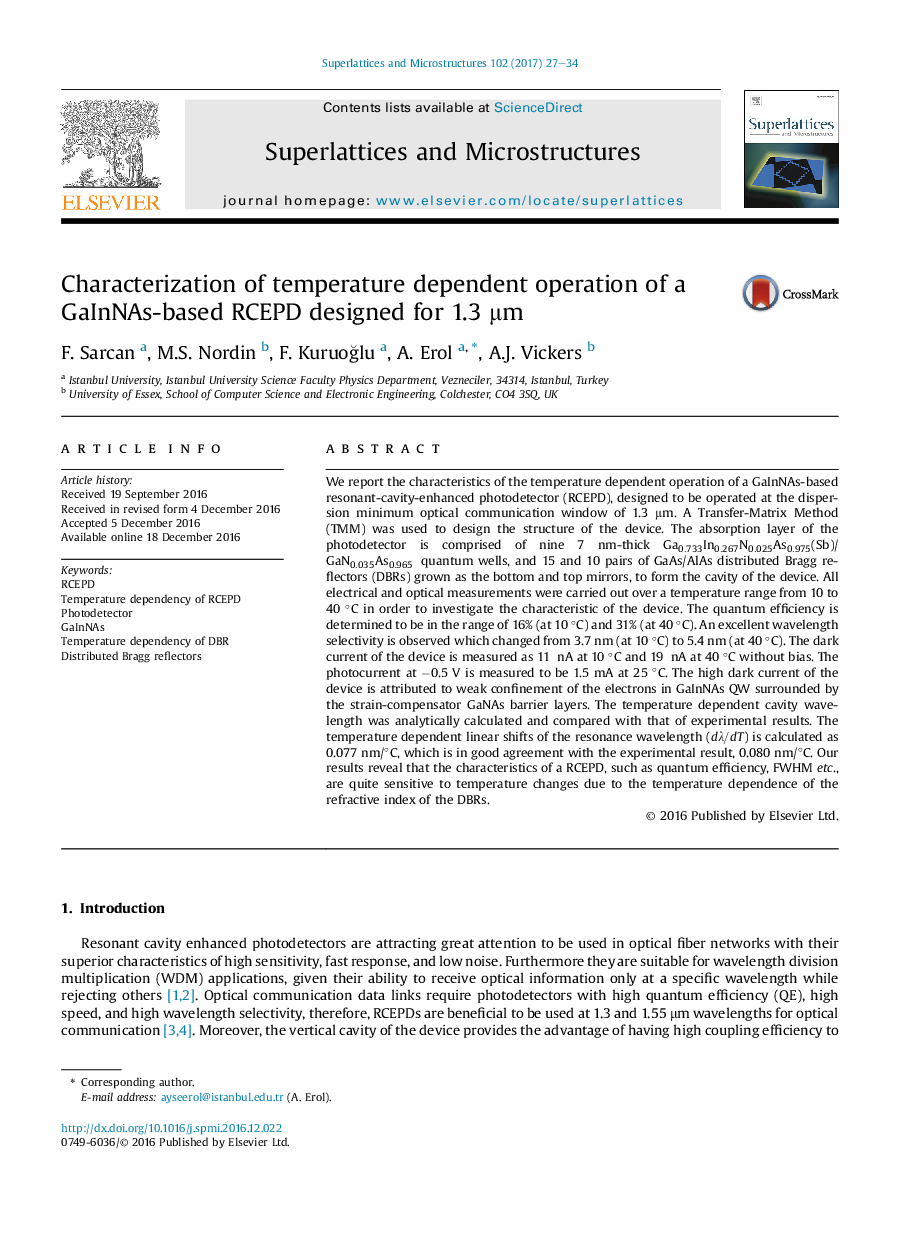| کد مقاله | کد نشریه | سال انتشار | مقاله انگلیسی | نسخه تمام متن |
|---|---|---|---|---|
| 7941055 | 1513199 | 2017 | 8 صفحه PDF | دانلود رایگان |
عنوان انگلیسی مقاله ISI
Characterization of temperature dependent operation of a GaInNAs-based RCEPD designed for 1.3 μm
دانلود مقاله + سفارش ترجمه
دانلود مقاله ISI انگلیسی
رایگان برای ایرانیان
کلمات کلیدی
موضوعات مرتبط
مهندسی و علوم پایه
مهندسی مواد
مواد الکترونیکی، نوری و مغناطیسی
پیش نمایش صفحه اول مقاله

چکیده انگلیسی
We report the characteristics of the temperature dependent operation of a GaInNAs-based resonant-cavity-enhanced photodetector (RCEPD), designed to be operated at the dispersion minimum optical communication window of 1.3 μm. A Transfer-Matrix Method (TMM) was used to design the structure of the device. The absorption layer of the photodetector is comprised of nine 7 nm-thick Ga0.733In0.267N0.025As0.975(Sb)/GaN0.035As0.965 quantum wells, and 15 and 10 pairs of GaAs/AlAs distributed Bragg reflectors (DBRs) grown as the bottom and top mirrors, to form the cavity of the device. All electrical and optical measurements were carried out over a temperature range from 10 to 40 °C in order to investigate the characteristic of the device. The quantum efficiency is determined to be in the range of 16% (at 10 °C) and 31% (at 40 °C). An excellent wavelength selectivity is observed which changed from 3.7 nm (at 10 °C) to 5.4 nm (at 40 °C). The dark current of the device is measured as 11  nA at 10 °C and 19  nA at 40 °C without bias. The photocurrent at â0.5 V is measured to be 1.5 mA at 25 °C. The high dark current of the device is attributed to weak confinement of the electrons in GaInNAs QW surrounded by the strain-compensator GaNAs barrier layers. The temperature dependent cavity wavelength was analytically calculated and compared with that of experimental results. The temperature dependent linear shifts of the resonance wavelength (dλ/dT) is calculated as 0.077 nm/°C, which is in good agreement with the experimental result, 0.080 nm/°C. Our results reveal that the characteristics of a RCEPD, such as quantum efficiency, FWHM etc., are quite sensitive to temperature changes due to the temperature dependence of the refractive index of the DBRs.
ناشر
Database: Elsevier - ScienceDirect (ساینس دایرکت)
Journal: Superlattices and Microstructures - Volume 102, February 2017, Pages 27-34
Journal: Superlattices and Microstructures - Volume 102, February 2017, Pages 27-34
نویسندگان
F. Sarcan, M.S. Nordin, F. KuruoÄlu, A. Erol, A.J. Vickers,